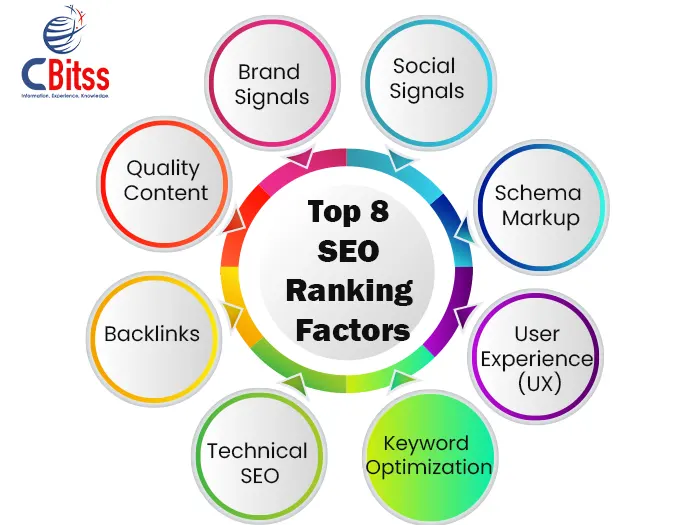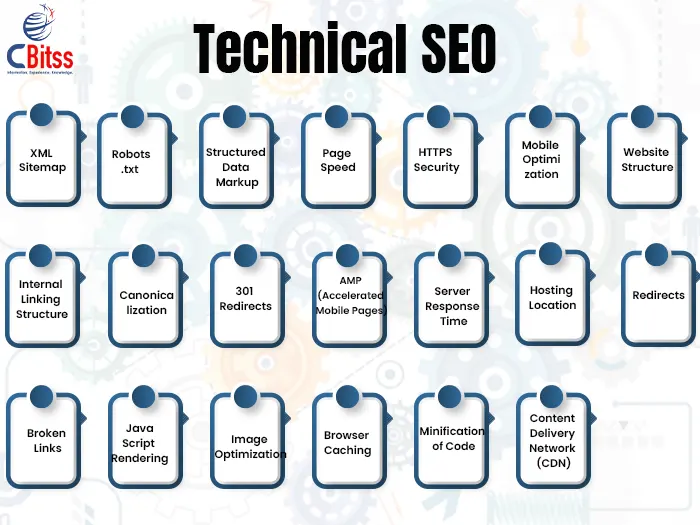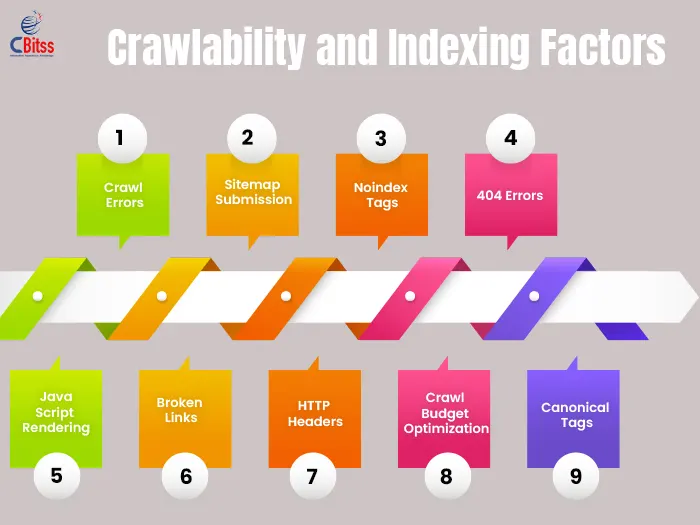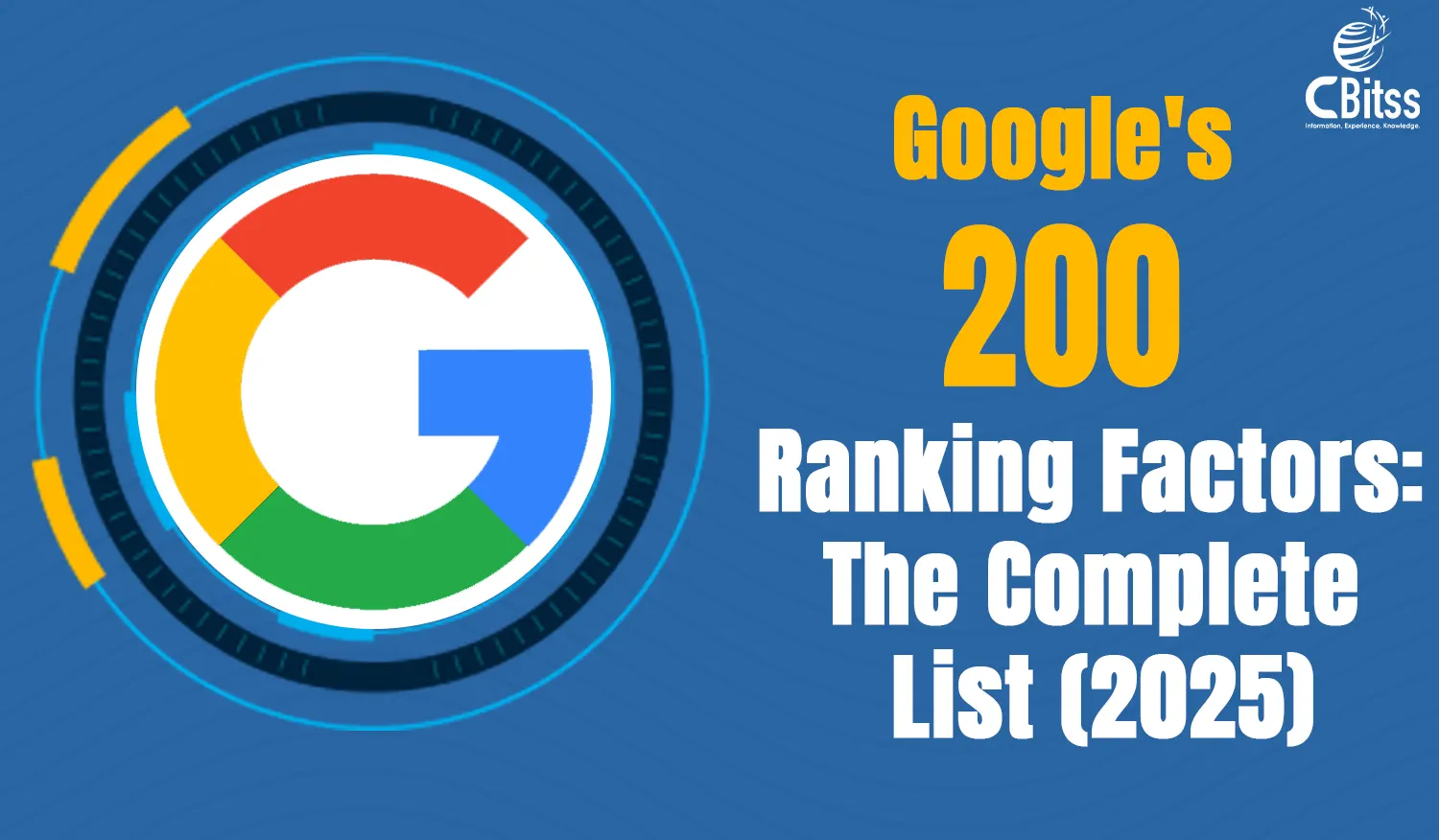Introduction
Google analyzes numerous elements through its ranking algorithm to establish a website’s placement in search results. Websites that want to achieve higher rankings must improve several critical areas such as content quality together with technical SEO, backlinks and user experience. This article, further presents Google’s 200 Ranking Factors- the complete List 2025 which are grouped into content factors, backlinks, on-page SEO, user experience, technical SEO among other categories.

1. Content Factors
1. Content Quality: Google favors content that surely delivers high-quality information that addresses users’ questions effectively.
2. Content-Length: While long-form content often achieves better search rankings through comprehensive information delivery, quality should not be compromised for quantity.
3. Content Freshness: An active website demonstrates its relevance to Google through continuous content updates indeed.
4. Keyword Relevance: Your content should incorporate target keywords seamlessly while fulfilling user requirements.
5. Keyword Placement: The strategic placement of keywords in titles, headers, as well as in body content enables Google to better interpret your website’s context.
6. LSI (Latent Semantic Indexing) Keywords: Improving content comprehensiveness and relevance requires using synonyms and also related terms.
7. Content Readability: Readable content benefits users while simultaneously enhancing SEO performance.
8. Content Depth: Comprehensive articles that thoroughly examine a subject perform better than brief content.
9. Engagement Metrics: Google uses time on the page along with bounce rate metrics to determine the overall quality of content.
10. Originality: Google gives preference to content that stands out because it is original and free from plagiarism.
11. Multimedia Usage: The inclusion of videos along with images and infographics serves to both enrich content quality and increase user interaction.
12. Internal Linking: Use internal links to direct users and search engines to related pages throughout your website.
13. External Linking: Establishing credibility in your content becomes easier when you link to authoritative sources.
14. Content Formatting: Using headings along with bullet points and lists enables readers to understand content more easily.
15. Structured Data: Schema markup surely improves search listings by incorporating rich snippets into them.
16. Content Uniqueness: Google prioritizes content that provides original insights.
17. Targeted Keywords in the First 100 Words: Using keywords at the start of your content enables Google to immediately identify the subject matter.
18. Multilingual Content: To achieve international reach you need to translate your content into multiple languages.
19. User-Generated Content: Google determines content relevance by analyzing overall user comments and reviews.
20. Content Relevance to User Intent: To create effective content you must ensure it matches both the informational and transactional intentions of your users.
2. Backlinks (Off-Page SEO)
21. Backlink Quality: A website undoubtedly gains credibility through links from well-established high-authority sites.
22. Backlink Quantity: Google without a doubt interprets a large number of backlinks as a sign of trustworthiness for your website.
23. Dofollow vs. Nofollow Links: Dofollow links certainly transfer authority which plays a crucial role in determining website rankings.
24. Anchor Text Relevance: While, backlinks must use anchor text that directly relates to the linked content.
25. Backlink Diversity: A varied backlink profile from sources like blogs as well as forums improves your website’s performance. is beneficial.
26. Backlink Relevancy: Backlinks from websites, similarly, in your industry sector have greater influence.
27. Backlink Placement: Content body links hold greater value compared to footer or sidebar links.
28. Backlink Velocity: The optimal link-building strategy involves developing backlinks at a consistent and also natural pace.
29. Editorial Backlinks: Backlinks acquired from high-quality content thus bring significant benefits.
30. Backlinks from .edu, .gov Domains: These backlinks are further highly authoritative.
31. Social Shares: The number of social shares people give content serves as an indirect measure of that content’s quality and relevance likewise.
32. Brand Mentions: In fact, your brand can achieve higher search rankings through brand mentions without requiring direct links.
33. Backlinks from Social Media: Social media backlinks operate as nofollow links but they can enhance both visibility and site traffic.
34. Link Diversity: A good backlink profile undoubtedly contains links from multiple sources and different domain types.
35. Linking from High PageRank Pages: Links from high-authority pages are surely more powerful.
36. Link Relevance to Page Topic: The most relevant backlinks eventually originate from content that aligns with your material.
37. Backlink Location: Backlinks positioned within the main body content usually transmit a higher authority compared to those located in footers.
3. On-Page SEO
38. Title Tag: The title must incorporate the target keyword within a maximum of 60 characters indeed.
39. Meta Description: Writing a compelling meta description within 160 characters undoubtedly boosts click-through rates.
40. URL Structure: Descriptive and also brief URLs should incorporate the main keyword.
41. Header Tags: By using H1, H2, and H3 tags, certainly you can structure your content in a logical manner.
42. Keyword in the URL: The target keyword should appear in the URL so to improve indexing performance.
43. Alt Text for Images: Search engines hence benefit from descriptive alt text for every image.
44. Mobile-Friendliness: Responsive design specifically that functions across all devices plays an essential role in achieving higher search engine rankings.
45. Page Speed: Fast-loading pages are surely prioritized by Google.
46. User Experience: Google gives higher ranking to websites that maintain a clean design with easy navigation because it keeps users interested.
47. SSL Certificate (HTTPS): Websites with security certificates receive higher ranking priority compared to those without security measures.
48. Mobile-First Indexing: Moreover, google now prioritizes indexing the mobile version of your website.
49. Internal Linking: Effective internal links spread link equity throughout your site in fact enhancing its SEO performance.
50. SEO-Friendly Images: Ensure all images have optimized sizes as well as descriptive file names for better SEO.
51. Content Formatting: Effective use of bullet points together with numbered lists and headings makes content easier to read.
52. Table of Contents: A table of contents enables users to thus locate specific sections of long-form content quickly.
53. Breadcrumbs: Breadcrumbs function as guides for users and search engines to understand overall your website structure.
54. Crawlable Text: Make sure essential information remains accessible outside of images or media files likewise.
55. Page Structure: Properly structured content enhances the user experience and search engine rankings especially.
56. Language of Content: When you translate your content into your audience’s native language it enhances SEO performance.
57. Canonical Tags: Furthermore, prevent duplicate content issues with proper canonicalization.
58. Content Freshness: Keep content up-to-date for relevancy and also rankings.
59. Mobile Usability: Your website needs to perform optimally on mobile screens while avoiding disruptive pop-up elements.
60. Content Interlinking: Generate more pageviews and improve rankings by creating overall links to related blog posts and pages.
61. H1 Tag Usage: Each page should contain a single H1 tag for its main title while using H2 and H3 tags for subheadings.
62. Avoid Flash: Flash technology in fact poses compatibility issues with mobile platforms and negatively impacts your website’s speed.
63. Structured Data Markup: Structured data improves how search engines understand and accordingly how it display your content.
64. Content Organization: Structure content in hierarchical layers to benefit both website users and search engine algorithms.
4. User Experience (UX)
65. Bounce Rate: A lower bounce rate shows that visitors discover what they certainly want without leaving the initial page.
66. Time on Site: Google evaluates your content more favorably when users spend extended periods on your site.
67. Pages per Session: When users navigate through multiple pages it demonstrates that they have a positive experience with your site.
68. Clear Calls to Action: Effective calls to action lead to increased user interaction as well as direct visitor navigation through your website.
69. Site Layout and Design: An attractive and streamlined design results in superior user satisfaction while boosting search rankings.
70. Search Intent Match: The content of your webpage therefore needs to deliver the user’s intended search purpose which could be informational, transactional, or navigational.
71. Interactivity: User engagement is encouraged through interactive elements such as quizzes, surveys, or engaging content.
72. Content Above the Fold: Generally, users should see essential information immediately without scrolling through the page.
73. Ad Experience: Excessive ads and intrusive pop-ups damage user experience which results in an increased bounce rate surely.
74. Accessibility: Design your site to be usable by disabled persons because this practice improves your search rankings.
75. Font Size and Readability: The content requires readability especially through easy-to-read fonts and sufficient spacing between text elements.
76. Navigation Menu: Using a simple and clear navigation menu boosts user experience while making it easier for Google to crawl your website.
77. Multimedia Optimization: Optimize your images and videos to speed up your site because large files tend to slow it down.
78. Easy-to-Find Contact Information: Providing easy access to contact information specifically helps establish trust among users and search engines.
79. No Intrusive Pop-Ups: Do not use pop-ups because they create disruptions for users particularly when accessed through mobile devices.
80. Core Web Vitals: The user experience metrics LCP, FID, and CLS assess page load speed, interactive performance, and visual stability. Then, websites that excel in these performance areas usually receive better search rankings.
5. Technical SEO

81. XML Sitemap: The submission of an updated and clean XML sitemap enables Google to crawl and index your website surely more effectively.
82. Robots.txt: Similarly, the correct setup of your robots.txt file directs Google to crawl appropriate pages on your website.
83. Structured Data Markup: Implementing schema.org markup actually enables search engines to accurately comprehend your page content.
84. Page Speed: Google certainly prioritizes fast-loading websites. So, boost website performance by optimizing images while implementing browser caching techniques and reducing superfluous scripts.
85. HTTPS Security: Google shows preference for websites that surely use HTTPS security over those that don’t.
86. Mobile Optimization: Google’s mobile-first indexing undoubtedly requires websites to be mobile-friendly to achieve high rankings.
87. Website Structure: Google can crawl and index your site more effectively when you use a logical and straightforward site architecture.
88. Internal Linking Structure: Further, organizing internal links transparently allows users and search engines to quickly find related content.
89. Canonicalization: Implement canonical tags to avoid duplicate content problems while combining ranking signals.
90. 301 Redirects: Utilizing 301 redirects effectively transfers link equity to new pages while preventing the occurrence of 404 errors.
91. AMP (Accelerated Mobile Pages): The AMP technology accelerates mobile page load times which leads to better user experiences alongside improved search engine rankings indeed.
92. Server Response Time: Users benefit from enhanced website performance and experience when server response time is rapid.
93. Hosting Location: Selecting a server position near your audience surely enables reduced latency and faster website performance.
94. Redirects: Excessive redirects should be avoided because they negatively affect your site speed and create confusion for search engines.
95. Broken Links: To maintain seamless navigation andalso optimize crawlability you must eliminate all broken internal and external links.
96. JavaScript Rendering: Firstly, your site must enable Googlebot to access and render all JavaScript-based content.
97. Image Optimization: Optimize images through compression techniques to increase page loading speeds while maintaining image quality.
98. Browser Caching: Implement browser caching to accelerate loading times during future visits to your site.
99. Minification of Code: Further, make your page load faster by reducing page size through CSS, JavaScript, and HTML minification.
100. Content Delivery Network (CDN): A CDN undoubtedly helps deliver your website’s static content from various worldwide locations which leads to faster load times.
6. Domain Factors
101. Domain Age: The age of a domain contributes to its perceived trustworthiness and authority also.
102. Domain Authority: Websites, therefore, with high domain authority tend to achieve better search engine rankings.
103. Domain Relevance: Web domains that match their hosted content surely show better search engine rankings.
104. Exact Match Domain (EMD): Exact match domains that include the target keyword can offer minor SEO benefits yet lead to over-optimization when used too often.
105. Domain Trustworthiness: Google regards websites as they have certainly maintained a track record of delivering high-quality content for many years as trustworthy.
106. Domain Registration Length: A domain that has been registered for multiple years demonstrates both stability and trustworthiness.
107. Country TLD (Top-Level Domain): Ceratinly, using a country-specific TLD (.co.uk, .ca, etc.) So, a domain with a regional top-level domain might achieve better search rankings within its specified geographic area.
108. Domain Name Length: Short domain names help users remember them better and also usually achieve better performance results.
109. Domain Ownership History: Ecentually, a domain’s reputation can be affected by its ownership history.
110. Brandable Domain Name: A memorable domain name that represents your brand improves both recognition and search engine rankings.
111. Subdomains: Strategically use subdomains because too many subdomains can weaken the main domain’s relevance.
7. Social Signals
112. Facebook Shares: Your website visibility improves when Facebook generates high engagement and shares.
113. Twitter Mentions and Shares: Twitter mentions and retweets demonstrate both the significance and relevance of content.
114. Pinterest Pins: Pinning content to Pinterest surely helps generate website traffic and establish backlinks.
115. LinkedIn Shares: LinkedIn sharing provides significant benefits for B2B companies by driving website traffic while building authority.
116. Social Media Activity: Active social media profiles that receive regular updates help expand brand recognition while supporting search engine optimization.
117. Social Signals: Google certainly receives indirect signals about content quality through social media mentions and engagements.
118. Social Profile Backlinks: Visibility and trustworthiness without a doubt improve through backlinks from your social media accounts.
8. Local SEO Factors
119. Google My Business Optimization: Improving your Google My Business profile therefore helps enhance local search visibility.
120. NAP Consistency (Name, Address, Phone Number): Online platforms should show matching business name, address, and phone number details.
121. Local Citations: Local directories aa well as website citations work to enhance local SEO performance.
122. Local Reviews: Trust and local rankings improve with positive reviews on platforms such as Google, Yelp, or Trustpilot.
123. Proximity to Searcher: Google uses the searcher’s current location to rank local search results undeniably.
124. Location in the Domain Name: A domain name that features a city or region designation thus can boost your local search engine optimization.
125. Local Backlinks: Local businesses or organizations providing backlinks can further improve local search rankings.
126. Google Maps Ranking: A properly optimized listing on Google Maps therefore enhances your local visibility.
127. Local Content: Produce material that directly speaks to your local community and geographic area likewise.
128. Local Business Schema Markup: Implement local business schema markup on your website to boost its visibility in local search engine results.
129. Mobile-Friendly Site: Mobile optimization of websites plays a critical role in local SEO performance for users who browse searches while traveling.
130. Online Reputation: The quality of local SEO performance depends on having positive reviews and ratings which constitute a strong online reputation accordingly.
9. User Behavior Signals
131. Click-Through Rate (CTR): Google interprets higher CTRs as an indication of your page being relevant to the user’s search query.
132. Dwell Time: Content quality gets stronger while validation through extended user page visits.
133. Bounce Rate: When your site displays a decreased bounce rate it shows that visitors find what they need and stay engaged with your content.
134. Pogo-Sticking: If users often return to search results after visiting your web page it can negatively impact your search rankings.
135. Direct Traffic: When there is extensive direct traffic, it demonstrates that users recognize your brand and they perceive your content as valuable.
136. User Feedback: Users express their appreciation for your content through their positive comments and ratings and also active engagement.
137. Engagement with Rich Snippets: User interaction with search result features such as star ratings and FAQs helps to increase engagement.
138. Search Result Interaction: User engagement patterns with search results influence rankings because people tend to click on your listing over others.
139. User Intent Alignment: When your content aligns with what users seek in their search queries you achieve better ranking positions and deliver enhanced satisfaction to your audience.
10. E-A-T (Expertise, Authoritativeness, Trustworthiness)
140. Author Expertise: Search algorithms tend to assign higher rankings to content produced by recognized experts in relevant subjects certainly.
141. Domain Authority: Google prioritizes domains that hold high authority because they are recognized as trustworthy sources.
142. Website Trustworthiness: Websites that maintain security standards along with transparency and a spam-free environment achieve better rankings indeed.
143. Author Reputation: Websites reach higher authority rankings when recognized field experts contribute their content.
144. Author Bios: Google identifies content as credible when it features well-defined author bios from experts.
145. External Recognition: The presence of mentions or backlinks from authoritative publications further enhances your site’s credibility.
146. Trust Signals: Establishing credibility becomes easier when websites implement trust signals like secure payment options and privacy policies.
147. User Reviews and Ratings: When real users leave positive reviews it demonstrates the trustworthiness of your website.
148. Expert Backlinks: Connecting your site to authoritative experts via backlinks surely boosts its trustworthiness.
149. Industry Recognition: When well-known industry leaders endorse your site it results in increased authority.
150. Content Accuracy: Website credibility grows from content that maintains accuracy through thorough research and fact-checking which demonstrates professional expertise indeed.
11. Video SEO
151. Video Title Optimization: The video title should contain keywords to help search engines determine its content.
152. Video Description: Write descriptions with detailed information and incorporate target keywords.
153. Video Length: Videos with extended durations that maintain audience attention typically achieve higher rankings.
154. Video Engagement: The ranking of videos is determined by their metrics which include likes, shares, comments, and watch time.
155. Video Content Relevance: For a video to achieve high search rankings it needs to closely match the search query.
156. Video Transcripts: Transcribing video content helps optimize both accessibility standards and search engine visibility.
157. Video Thumbnails: Videos with attention-grabbing thumbnails receive more clicks which helps improve their ranking positions.
158. Embedded Videos: Embedding videos directly into your website boosts user interaction while supporting SEO efforts.
159. Video Sitemap: A video sitemap submission allows search engines to index video content properly.
160. Video Host Site: SEO benefits from placing videos on reputable platforms such as YouTube.
12. Content Marketing and Strategy
161. Guest Blogging: Establishing backlinks through posts on authoritative industry websites adds value to your link profile.
162. Content Repurposing: When you transform content into multiple formats such as articles, videos and infographics you can connect with larger audiences.
163. Content Consistency: High-quality content posted on a consistent schedule ensures your website remains up-to-date and relevant.
164. Content Promotion: You can expand your content’s reach and drive traffic by actively distributing it through social media platforms and email or outreach strategies.
165. Linkable Assets: High-value content such as tools or case studies receives backlinks naturally.
166. Content Collaborations: Collaborations with influencers or established industry leaders can increase your content exposure while also generating more backlinks.
167. Content Syndication: Your content visibility expands and search rankings improve when you republish on respected platforms.
168. Content Updates: Eventually, periodic updates to older posts with fresh information enhance their usefulness and relevance.
169. Content Testing: By conducting A/B tests on varying content formats you can determine which types engage your audience most effectively.
170. Comprehensive Content Strategy: SEO success depends on a comprehensive content marketing plan that utilizes multiple channels such as blogs, videos, and social media.
13. Brand Signals
171. Brand Mentions: Your brand receives recognition when people mention it online because it demonstrates trustworthiness and authority.
172. Branded Searches: Specific searches for your brand name indicate strong user interest while proving to Google that your brand possesses authority.
173. Brand Visibility: Specifically, your brand’s visibility and recognition directly influence your rankings positively.
174. Social Proof: Your SEO performance improves through the positive social validation provided by reviews, mentions, and recommendations.
175. Brand Reputation: Your website’s authority and ranking improve when your brand maintains a strong positive reputation throughout the internet.
176. Content Associated with a Strong Brand: Content from reputed brands achieves better search rankings when it maintains high quality.
177. Brand Loyalty: Recurring visitors along with brand supporters generate stable traffic in order to boost search engine rankings.
178. Consistent Branding Across Channels: When your website, social media presence, and additional platforms share consistent branding it boosts both recognition and authority.
179. Brand Authority: Establishing yourself as an industry expert or thought leader builds trust for your site and enhances your search rankings.
180. Brand Loyalty: A loyal customer base demonstrates trust in your business which can indirectly affect your rankings accordingly.
14. Crawlability and Indexing
181. Crawl Errors: When you correct crawl errors you allow Google to access and index your content in an efficient manner.
182. Sitemap Submission: Google Search Console receives updated sitemaps which allows for quicker and more precise indexing of your web pages.
183. Noindex Tags: By applying noindex tags to pages that don’t require indexing (such as thank-you pages) you prevent search engines from crawling them unnecessarily.
184. 404 Errors: Resolving 404 errors and setting up correct 301 redirects leads to better performance in both user experience and search engine crawling efficiency.
185. Robots.txt: Correct robots.txt settings thus enable search engines to crawl just the key pages of your website.
186. JavaScript Rendering: Make sure Googlebot can access JavaScript-rich websites, so can display their content properly.
187. Broken Links: Repairing broken internal and external links simultaneously improves user navigation and assists Google in effectively crawling your website.
188. HTTP Headers: Appropriate HTTP header responses such as 200 OK ensure that search engines can properly crawl and index your web pages.
189. Crawl Budget Optimization: Through crawl budget optimization, further, Google’s crawling process becomes more effective for large websites’ essential pages.
190. Canonical Tags: Canonical tags resolve duplicate content problems while they also combine ranking signals.

15. Technical Site Optimization
191. Lazy Loading: Lazy loading images and videos boosts page loading speed certainly without affecting quality.
192. Content Delivery Network (CDN): The Content Delivery Network further speeds up content delivery by spreading its resources across multiple worldwide locations resulting in enhanced user experiences.
193. Minification of CSS, JS, and HTML: Page load speeds increase when you reduce the file sizes of CSS JavaScript, and HTML documents.
194. Browser Caching: Utilize browser caching to keep static resources on local storage which enhances page load speeds during future visits.
195. Image Compression: Image compression achieves quicker page load speeds while maintaining the quality of visuals.
196. Responsive Design: Mobile-responsive websites enable consistent user experiences on various devices, thus enhance search engine rankings.
197. Proper 301 Redirects: Implement 301 redirects to maintain link equity when you permanently relocate a page to prevent 404 errors.
198. Fix Broken Internal Links: Broken internal links create confusion for users and search engines which makes site crawling harder so fixing them improves crawlability.
199. Avoid JavaScript-Heavy Sites: Avoid hiding critical content within JavaScript so that search engines can properly index it.
200. Server Location: Selecting a server location near your target audience minimizes latency while enhancing load speed to benefit SEO indirectly.
Websites further need to establish a comprehensive SEO strategy to achieve higher rankings in Google search results. The success of online search rankings depends on content optimization as well as high-quality backlink acquisition alongside technical SEO improvements and user experience enhancement. A website that stays current and maintains authority alongside engaging content encourages sustainable growth undoutedly. Effective application of the 200 ranking factors enables you to boost organic traffic while enhancing search visibility and maintaining a competitive advantage online.


